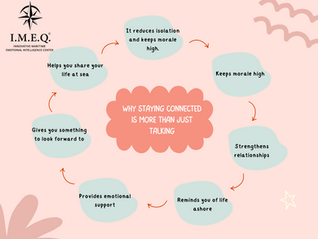Tackling Burnout as a Seafarer: A Comprehensive Guide
- IMEQ CENTER

- Oct 1, 2023
- 2 min read

Burnout, a state of physical or emotional exhaustion, especially as a result of prolonged stress and/or overwork, is not uncommon in the seafaring profession. The unique working and living conditions on a ship can exacerbate feelings of isolation, stress, and fatigue. It's crucial for seafarers to actively tackle burnout to ensure their well-being and maintain the safety and efficiency of operations at sea. This article outlines a detailed, step-by-step approach to dealing with burnout as a seafarer, providing practical solutions and tips.
Recognize the Signs
Step 1: Understand the Symptoms
Acknowledge the early signs of burnout, which can include
chronic fatigue
irritability
insomnia
increased illness
decreased productivity
and feelings of detachment or hopelessness
Step 2: Self-Assessment
Conduct a self-assessment to determine your mental and physical state. If you recognize the symptoms of burnout, take them seriously and prioritize addressing them. You may also contact IMEQ CENTER for a burn out assessment.
Communication
Step 3: Talk to Someone
Open up to family, friends, or colleagues about how you are feeling. Communicating your experiences and feelings with others can provide emotional support and practical insight. You may also share with the Mental Health Group in our IMEQ SEAFARERS'APP!
Step 4: Inform Your Supervisor
It's crucial to let your supervisor know about your condition. They can help modify your workload or provide additional resources to help you manage your stress.
Implement Changes
Step 5: Redefine Your Goals
Reassess your professional and personal goals. Having a clear sense of purpose can help alleviate feelings of burnout.
Step 6: Establish Boundaries
Set clear boundaries to separate your work time from your personal time. Even at sea, allocate time for rest and leisure activities.
Focus on Physical and Mental Well-being
Step 7: Prioritize Sleep
Ensure you are getting adequate and consistent sleep. Sleep is fundamental to physical health and effective functioning.
Step 8: Healthy Eating and Hydration
Consume a balanced diet and stay hydrated. Proper nutrition is essential for maintaining energy levels and resilience to stress.
Step 9: Engage in Physical Activity
Integrate regular physical activity into your routine. Exercise helps release built-up tension and stress. Check out our FITNESS GROUP where we share tips and links on exercises.
Step 10: Practice Mindfulness or Meditation
Engage in mindfulness exercises or meditation. These practices can help restore emotional balance and reduce stress.
Seek Professional Assistance
Step 11: Consider Professional Counseling
If burnout symptoms persist, consider seeking professional counseling or mental health services. Therapists or psychologists can offer strategies for managing stress and addressing burnout.
Take Leave if Necessary
Step 12: Utilize Your Leave
Don’t hesitate to take leave if necessary. Time away from the work environment can provide a much-needed break to recover and rejuvenate.
Tackling burnout as a seafarer is vital for ensuring not only the well-being of the individual but also the safety and efficiency of maritime operations. Recognizing the signs, communicating with others, implementing positive changes, focusing on physical and mental health, seeking professional assistance, and taking leave when necessary, are essential steps in addressing and preventing burnout in the seafaring profession.
Navigating the seas should not mean navigating stress and burnout alone. Utilize these steps to ensure you remain healthy, happy, and productive in your seafaring career.





































































































Comments